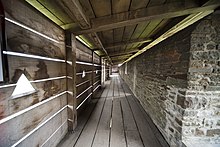Hoarding (castle)
In this article we will thoroughly explore everything related to Hoarding (castle). From its origin and evolution to its relevance today, through its applications in different areas and its impact on society. Through a detailed analysis, we will take an in-depth look at Hoarding (castle), breaking down its main features and highlighting its importance in the current context. In addition, we will highlight the different perspectives and opinions that exist around Hoarding (castle), as well as the possible future implications that they could have in various aspects of daily life. With this article, we aim to offer a complete and enriching overview of Hoarding (castle), in order to provide our readers with a broader and more solid understanding of this topic.

A hoard or hoarding was a temporary wooden shed-like construction on the exterior of a castle during a siege that enabled the defenders to improve their field of fire along the length of a wall and, most particularly, directly downwards towards the bottom of the wall. The latter function was the purpose of the invention of machicolations, which were an improvement on hoardings, not least because masonry is fire proof. Machicolations are also permanent and always ready for a siege.
It is suspected that hoardings were stored as prefabricated elements in peacetime. Construction of hoardings was often facilitated by putlog holes, sockets that were left in the masonry of castle walls for wooden joists called "putlogs". However, some hoardings were supported on permanent stone corbels.
Some medieval hoardings have survived, including examples on the north tower of Stokesay Castle, England, and the keep of Laval, France. The Château Comtal of Carcassonne and the keep of Rouen Castle, both in France, have reconstructed wooden hoardings, and also Castell Coch in South Wales, which was wholly rebuilt in 1875 and which has a hoarding over the drawbridge designed by the Victorian architect William Burges. Another reconstructed hoarding can be seen in Caerphilly Castle, also in South Wales, which extends along the northern curtain wall of the inner bailey.

See also
References
- ^ a b Hull, Lisa E (2006), Britain's Medieval Castles, Praeger Publishers, ISBN 0-275-98414-1 (p. 67)
- ^ Hogg, Ian V (1975), Fortress: A History of Military Defence, Macdonald and Jane's, ISBN 0-356-08122-2 (p. 21)
- ^ Lepage, Jean-Denis G G (2002), Castles and Fortified Cities of Medieval Europe: An Illustrated History, McFarland & Company Inc, ISBN 978-0-7864-6099-1 (p. 49)
- ^ Thompson, A Hamilton (1912, reprinted 2005), The English Castle: An Account of Its Development as a Military Structure, Dover Publications Inc, ISBN 0-486-44012-5 (p. 81)
- ^ Hourihane, Colum (editor) 2012, The Grove Encyclopedia of Medieval Art and Architecture: Volume 1, Oxford University Press, ISBN 978-0-19-539536-5 (p. 236)
- ^ Thompson, p. 82
- ^ Pettifer, Adrian (2000), Welsh Castles: A Guide by Counties, The Boydell Press, ISBN 0-85115-778-5 (p. 91)